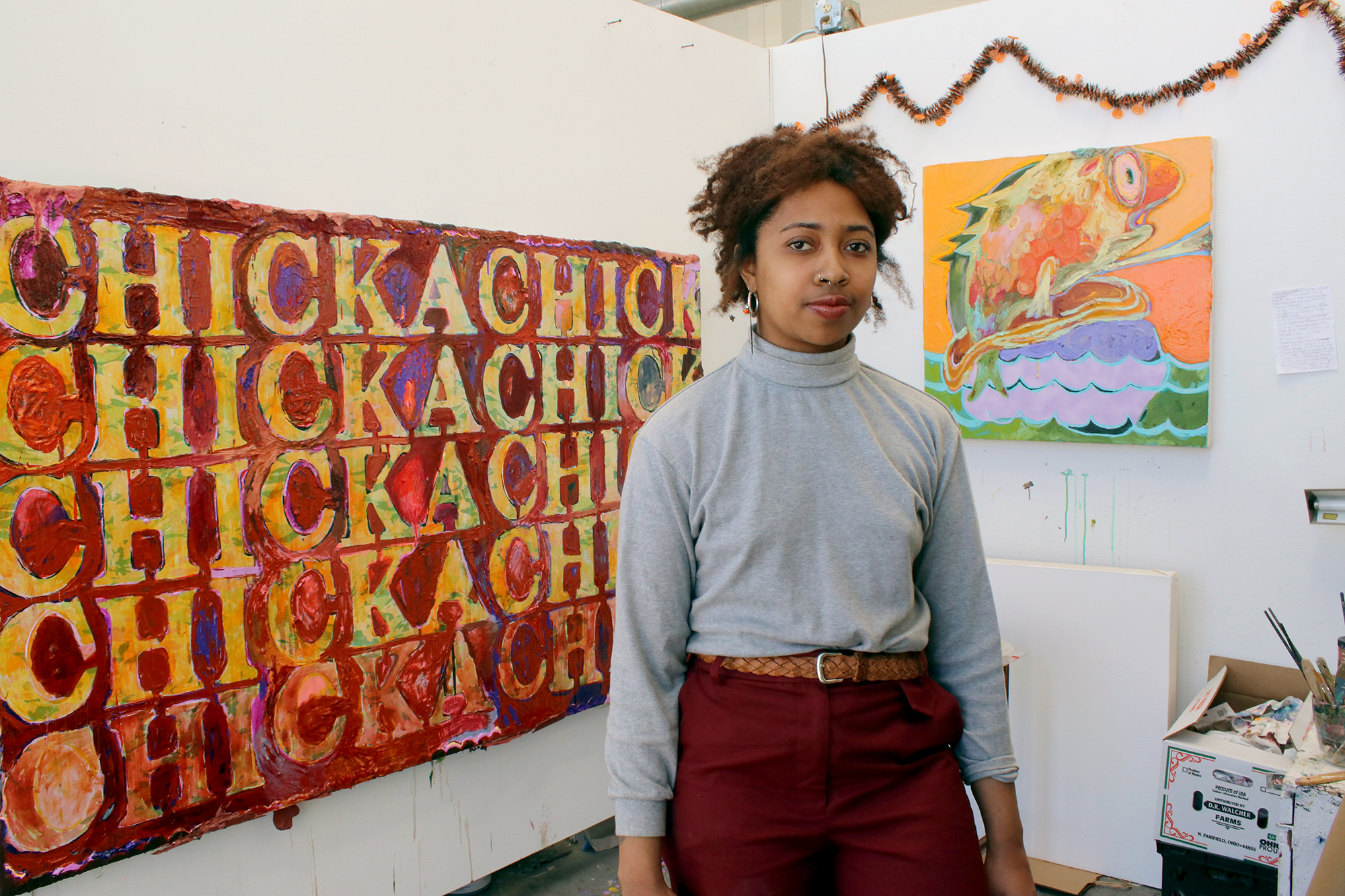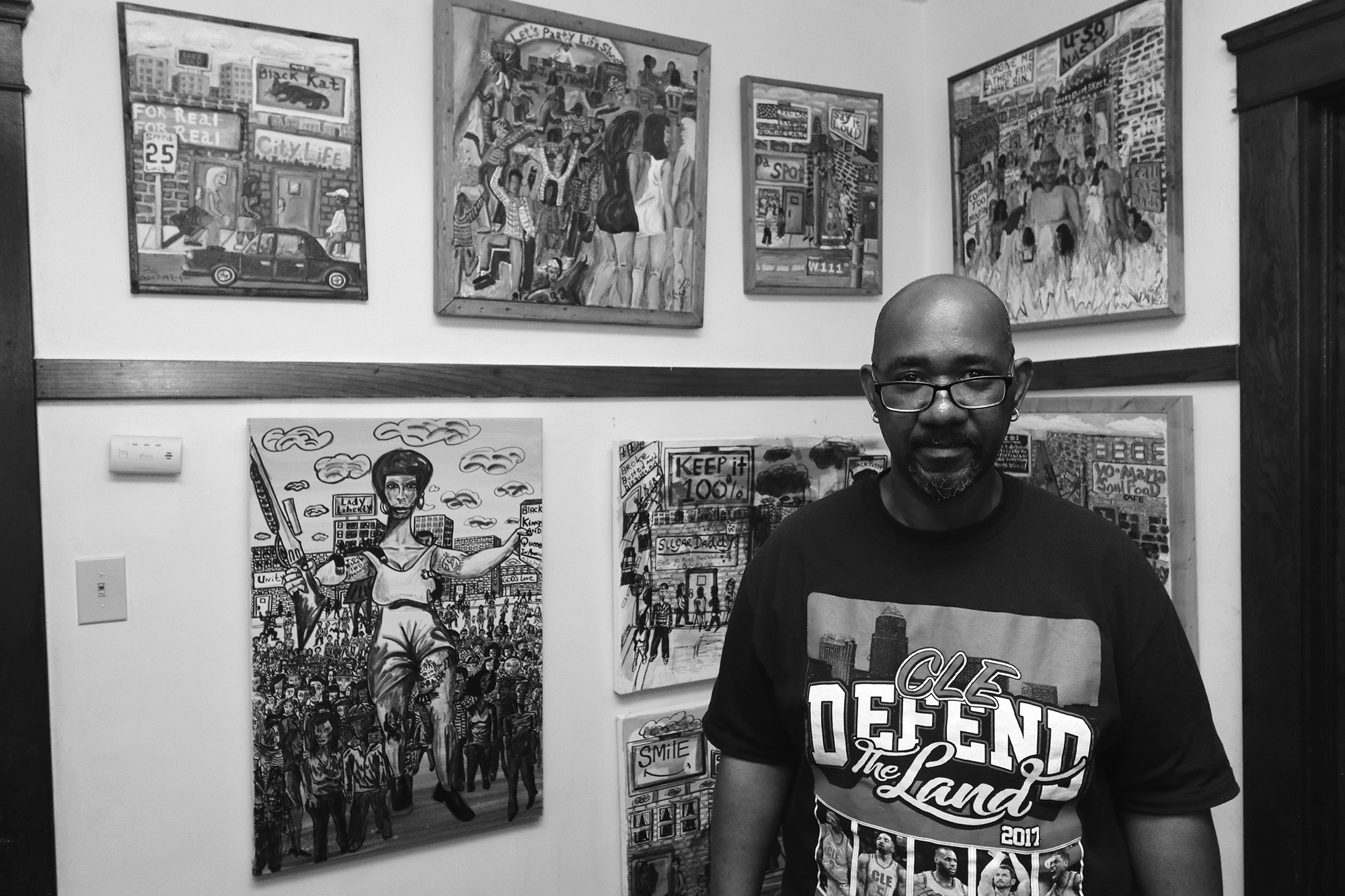The sculptures of Peter Christian Johnson trap chaos as it spills
Story by Carlo Wolff
Photography by Michael C. Butz
When Peter Christian Johnson was in graduate school at Pennsylvania State University, he realized making pottery wasn’t something he could commit to as a profession. It was then that Johnson had a thought that’s lasted longer than an epiphany: The vessel isn’t what matters, it’s the idea of the vessel.
Johnson has been vamping on that notion ever since, and he practices what he preaches. He is assistant professor/ceramics department head at the Kent State University School of Art. Johnson joined KSU in 2015 after 11 years at Eastern Oregon University in LaGrande, some 260 miles east of Portland.
“I was making these sort of still lifes of pots and clay chunks and steel,” Johnson says of those days at Penn State during an interview in his Kent State studio. “They were ‘abstract-ish,’” he adds, noting he became less interested in the “vessel” and more “in the language.”
“I just moved from the vessel – literally, a piece of pottery – to exploring ideas of containment, and over time, this work has become more architectural, and it’s been way more than a decade; it’s morphed. Now, I’m interested in a whole new set of things: The sort of idea of collapse, the phenomenology of material. So much of this to me is about man-made labor and structure and this sort of collapse.”
Keeping it together

“Collapsing Trestles” (detail) by Peter Christian Johnson; 13 x 35 x 8 inches, porcelain, 2017. Image courtesy of the artist.
What’s paradoxical and compelling about Johnson’s work is that his images of breakdown, painstakingly made from finicky and malleable porcelain, are highly structured. His studio is a miniature construction site, with works that resemble buildings in various stages. One snakes its way across a table; another, which may be a bridge punched in the gut to yaw toward the ground, conjures a hammock you’d rather not sink into; one large piece evokes the Kaiser Wilhelm Memorial Church in Berlin, which was nearly destroyed in World War II. That city never rebuilt the cathedral, preferring to allow its proud ruins to contrast with its adjacent contemporary successor. That way, it’s a reminder of the brokenness that lashes Johnson’s world even as it spurs his pointed, sturdy art.
The “icing,” or melt, atop many of these serves to ground them, and always is in a primary color that give them “strangeness” and makes them “more foreign” to observers. He wants someone to work to arrive at his or her own conclusions rather than hand it to the person. As a result, earth tones, apparently, went the way of his pottery.
Johnson recalls driving by barns in Oregon and Ohio that are falling in on themselves and embody “this sense of time and sort of labor.” His contradictory work encompasses both in process and product.
He also speaks of the old railroad trestles that serve as models for what he calls “clouds,” spiky porcelain aggregates that look like they’d cut you at the touch. “What I’m working on lately is that trestle,” he says, also citing 19th-century wooden bridges “that were made honestly with slaves to indentured servitude.” Such bridges “have all this intricate structure that relates to labor,” he adds, noting he’s inspired by the ingredients of cities more than the city as a whole.
What remains behind moves Johnson.
“The structure becomes something that’s so much about man-made building. Like it’s labor, it’s not only about the way (it’s made), maybe there’s a Tower of Babel metaphor where we’re building these things, but we’ve really screwed up.”
Course correction

“Wasteland,” in the foreground, at “POISE: Peter Christian Johnson,” an exhibition held in 2016 at Ferrin Contemporary in North Adams, Mass. Image courtesy of the artist and John Polak.
Johnson is both cerebral and hands-on. He starts with incredibly precise computer drawings, trudges through assembly and climaxes with firing his ceramics to within the perfect, torrid inch of their lives. One of three sons of a man who worked construction, including in the oil industry near Houston, where much of his childhood was spent, Johnson grew up making things.
After high school, he matriculated at Wheaton College in Illinois, near Chicago, and enrolled in pre-med courses. Johnson eventually would earn a bachelor of science degree in environmental studies from Wheaton College, but along the way, he took a general education art course that changed his life and put him on his true path.
Credit the professor, who was just eccentric enough and inspired so much love for art in Johnson that, after he graduated (with an art minor), he offered to build a studio in the professor’s two-car garage in exchange for permission to use it part-time.

Johnson lays the groundwork for a piece in his Kent State University studio.
At the same time, he was torn over whether to take the Medical College Acceptance Test, admitting he was “trying to decide if I had the guts to not go to medical school and be an artist.”
Art won out when a friend told him of an artist-in-residence opening at the Odyssey Center For Ceramic Arts. “I got it and moved to North Carolina and lived there for three years as a resident artist,” he says.
That immersion in ceramics in the River Arts district of Asheville made him a professional – and an explorer. “I wanted to figure out how to make the clay do the thing I wanted to do,” he says. “Learning the potter’s wheel was like learning a table saw.”
His construction genes drove his talent for figuring things out and making things, he suggests: “Ceramics was interesting to me because it was so focused on learning skills.”
Not that learning by way of his father’s employ was easy or pleasant; Johnson speaks of himself and his brothers being “indentured servants” to their dad. Perhaps his artistic forays are a way for him to break free.
In 2003, Johnson earned his master of fine arts degree from Penn State, and since about that same time, he’s shown in solo and two-person exhibitions. Among his more recent shows have been “Remnants” at Santa Fe Clay in Santa Fe, N.M., in 2013; “Collapse” at the Sheehan Gallery in Walla Walla, Wash., in 2015; and “Poise,” at Ferrin Contemporary & Independent Art Projects, North Adams, Mass., in 2016.
In Ohio, his work was recently on view at the Dairy Barn Arts Center in Athens and at Hammond Harkins Galleries in Columbus. He just won first place/sculptural for “Little Gidding,” his homage to one of T.S. Eliot’s “Four Quartets,” in the Zanesville Prize for Contemporary Ceramics contest. That garish, imposing work recently was on view at Sellers’ Studio and Gallery in Zanesville.
Heat of the moment

“Little Gidding” by Peter Christian Johnson;
31 x 15 x 14 inches, porcelain, 2016. Image courtesy of the artist.
Johnson’s goal is to trap humanity as it is about to lapse, to capture the power of a structure before it falls apart. They’re essentially the same to him, and he relates to the writing of such dark poets of the human spirit as the Russian novelist Fyodor Dostoevsky and the Gothic American storyteller Flannery O’Connor.
Johnson points to his sculpture of a failed bridge as prelude to a riff on reading.
“Reading Catholic literature or Dostoevsky or Flannery O’Connor, it seems the most screwed-up person is always the most spiritual,” he says. “It’s this sort of failure when it comes to the human part, to the brokenness, whatever word you want to put in there.”
The sag, the crack, the drip – pinning all that at a high-heat moment is the prize.
“I’ll look through the opening in the kiln and watch it when it’s at 2,000-plus degrees, and I can see the melt, I can see enough information to stop the kiln when I think it might be beautiful.
“There’s a sort of sweet spot,” he says. “There’s a poetic place that I want to be sort of beautiful and tragic.”
Gianna Commito, associate professor of painting and drawing at Kent State, describes Johnson’s three-dimensional constructions succinctly:
“Peter Johnson’s sculptures are exercises in chance, vulnerability and persistence. He is meticulous in the initial engineering and construction of his forms, only to allow them to partially (and sometimes completely) collapse during the firing process. His willingness to allow his sculptures to potentially ‘fail’ is ultimately the result of his mastery of the materials and processes he employs: the ideal clay body, glaze recipe, firing temperature. These physical manifestations of entropy and collapse evoke larger conceptual issues within religion, government and social structures, without becoming illustrative or heavy-handed.”
Paradoxes intrigue Johnson. Contradictions are not a hurdle.
“In failure, there is virtue,” he says. “In a lack of perfection, there becomes something, something more human, something more generous, something more honest.”
Working it out

Drawings, notes and in-progress works fill Johnson’s studio.
Johnson, 41, his wife and their two children live in Kent, near the city’s border with Streetsboro. Johnson is building a barn. He doesn’t enjoy the toil, but at the end, he’ll have a barn. Word is it may be an annex to his Kent State studio.
“I make stuff to see it made, so I don’t love the process,” he says. “The process just seems like labor, a means to an end. I have gratification in some engineering, like in imagining how to make something. Is it possible? I like the problem-solving stage before I actually make it.”
The work itself, however, is like mowing the lawn.
“I’m making it because I want to see it. I want it to go from my head to the physical world and then I want to know if it’s going to be beautiful or amazing, and that’s the mystery, that’s the reason for the labor.”
Over time, he has come to realize “the work had to feel laborious,” so that at the end, there’s a tension.
“In architecture, you’re making the real thing, and I’m making the thing that’s really about the idea of the thing,” Johnson says. “I’m trying to engineer something that’s not possible; sometimes I’ll just play.”
That play part seems secondary, however. “I will spend days prepping, making the parts, modeling it, making the blueprints I need to lay everything out, cutting all the parts, setting them aside for when I build it,” he says. He has to work fast, and he does, at times in 15-hour sessions. He has to assemble before his porcelain dries out. Why work with “really fussy” white material?
“It has this purity to it, at least the illusion of it,” he says. “Because it’s the only clay that has no iron content, which is why it’s so expensive. That whiteness is so desired.” Not only in art, either; think places where the desired effect is purity – think bathrooms, think hospitals.
Think task, too, because Johnson’s art is about a dual task: preservation and transformation. His latticework “buildings” may be miniatures, but the thought and the work that go into them are, one might say, huge.
“Let’s make the structure out of little sticks of porcelain that don’t want to work that way,” Johnson says, laughing in the face of his satisfying Sisyphean struggle. CV
Lead image: Johnson discusses his work inside his studio at Kent State, where he’s an assistant professor and head of the ceramics department.











